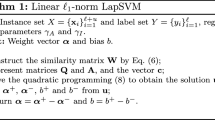Abstract
Laplacian support vector machine (LapSVM), which is based on the semi-supervised manifold regularization learning framework, performs better than the standard SVM, especially for the case where the supervised information is insufficient. However, the use of hinge loss leads to the sensitivity of LapSVM to noise around the decision boundary. To enhance the performance of LapSVM, we present a novel semi-supervised SVM with the asymmetric squared loss (asy-LapSVM) which deals with the expectile distance and is less sensitive to noise-corrupted data. We further present a simple and efficient functional iterative method to solve the proposed asy-LapSVM, in addition, we prove the convergence of the functional iterative method from two aspects of theory and experiment. Numerical experiments performed on a number of commonly used datasets with noise of different variances demonstrate the validity of the proposed asy-LapSVM and the feasibility of the presented functional iterative method.




Similar content being viewed by others
Notes
References
Balasundaram S, Benipal G (2016) On a new approach for Lagrangian support vector regression. Neural Comput Appl. 29(9):533–551
Belkin M, Niyogi P, Sindhwani V (2006) Manifold regularization: a geometric framework for learning from labeled and unlabeled examples. J Mach Learn Res 7:2399–2434
Bi J, Zhang T (2004) Support vector classification with input data uncertainty. Neural Inf Process Syst (NIPS) 17:161–168
Calma A, Reitmaier T, Sick B (2018) Semi-supervised active learning for support vector machines: a novel approach that exploits structure information in data. Inform Sci 456:13–33
Chapelle O, Scholkopf B, Zien A (2006) Semi-supervised learning. MIT Press, Cambridge
Chen W, Shao Y, Xu D, Fu Y (2014) Manifold proximal support vector machine for semi-supervised classification. Appl Intell 40:623–638
Cristianini N, Shawe-Taylor J (2000) An introduction to support vector machines and other kernel-based learning methods. Cambridge University Press, Cambridge
Demsar J (2006) Statistical comparisons of classifiers over multiple data sets. J Mach Learn Res 7:1–30
Du B, Tang X, Wang Z, Zhang L, Tao D (2019) Robust graph-based semisupervised learning for noisy labeled data via maximum correntropy criterion. IEEE Trans Cybern 49(4):1440–1453
Fung G, Mangasarian OL (2004) A feature selection Newton method for support vector machine classification. Comput Optim Appl 28(2):185–202
Gu N, Fan P, Fan M, Wang D (2019) Structure regularized self-paced learning for robust semi-supervised pattern classification. Neural Comput Appl 31(10):6559–6574
Guzella TS, Caminhas WM (2009) A review of machine learning approaches to spam filtering. Expert Syst Appl 36(7):10206–10222
Huang G, Zhu Q, Siew C (2006) Extreme learning machine: theory and applications. Neurocomputing 70:489–501 (Neural Networks Selected Papers from the 7th Brazilian Symposium on Neural Networks, SBRN’04)
Huang X, Shi L, Suykens JAK (2014) Support vector machine classifier with pinball loss. IEEE Trans Pattern Anal Mach Intell 36(5):984–997
Huang X, Shi L, Suykens JAK (2014) Asymmetric least squares support vector machine classifiers. Comput Stat Data Anal 70:395–405
Huang G, Song S, Gupta J, Wu C (2014) Semi-supervised and unsupervised extreme learning machines. IEEE Trans Cybern 44:2405–2417
Jumutc V, Huang X, Suykens JAK (2013) Fixed-size Pegasos for hinge and pinball loss SVM. In: Proceedings of the international joint conference on neural network, Dallas, TX, USA. pp 1122–1128
Khemchandani R, Pal A (2016) Multi-category Laplacian least squares twin support vector machine. Appl Intell 45:458–474
Koenker R (2005) Quantile regression. Cambridge University Press, Cambridge
Li Z, Tian Y, Li K, Zhou F, Yang W (2017) Reject inference in credit scoring using semi-supervised support vector machines. Expert Syst Appl 74:105–114
Lu L, Lin Q, Pei H, Zhong P (2018) The aLS-SVM based multi-task learning classifiers. Appl Intell 48:2393–2407
Ma J, Wen Y, Yang L (2019) Lagrangian supervised and semi-supervised extreme learning machine. Appl Intell 49(2):303–318
Melki G, Kecman V, Ventura S, Cano A (2018) OLLAWV: online learning algorithm using worst-violators. Appl Soft Comput 66:384–393
Pei H, Chen Y, Wu Y, Zhong P (2017) Laplacian total margin support vector machine based on within-class scatter. Knowl-Based Syst 119:152–165
Pei H, Wang K, Zhong P (2017) Semi-supervised matrixized least squares support vector machine. Appl Soft Comput 61:72–87
Pei H, Wang K, Lin Q, Zhong P (2018) Robust semi-supervised extreme learning machine. Knowl-Based Syst 159:203–220
Scardapane S, Fierimonte R, Lorenzo PD, Panella M, Uncini A (2016) Distributed semi-supervised support vector machines. Neural Netw. 80:43–52
Shivaswamy P, Bhattacharyya C, Smola A (2006) Second order cone programming approaches for handling missing and uncertain data. J Mach Learn Res 7:1283–1314
Steinwart I, Christmann A (2008) Support vector machines. Springer, New York
Sun S (2013) Multi-view Laplacian support vector machines. Appl Intell 41(4):209–222
Tikhonov AN (1963) Regularization of incorrectly posed problems. Sov. Math. Dokl 4:1624–1627
Tur G, Hakkani-Tür D, Schapire RE (2005) Combining active and semi-supervised learning for spoken language understanding. Speech Commun 45(2):171–186
Vapnik VN (1995) The nature of statistical learning theory. Springer, New York
Wang K, Zhong P (2014) Robust non-convex least squares loss function for regression with outliers. Knowl-Based Syst 71:290–302
Wang K, Zhu W, Zhong P (2015) Robust support vector regression with generalized loss function and applications. Neural Process Lett 41:89–106
Xu H, Caramanis C, Mannor S (2009) Robustness and regularization of support vector machines. J Mach Learn Res 10:1485–1510
Ye J (2005) Generalized low rank approximations of matrices. Mach Learn 61(1–3):167–191
Zhang T, Liu S, Xu C, Lu H (2011) Boosted multi-class semi-supervised learning for human action recognition. Pattern Recognit 44(10–11):2334–2342
Zhao J, Xu Y, Fujita H (2019) An improved non-parallel Universum support vector machine and its safe sample screening rule. Knowl-Based Syst 170:79–88
Zhong P (2012) Training robust support vector regression with smooth non-convex loss function. Optim Methods Softw 27(6):1039–1058
Acknowledgements
The authors gratefully acknowledge the helpful comments and suggestions of the reviewers, which have improved the presentation.
Author information
Authors and Affiliations
Corresponding author
Additional information
Publisher's Note
Springer Nature remains neutral with regard to jurisdictional claims in published maps and institutional affiliations.
Rights and permissions
About this article
Cite this article
Pei, H., Lin, Q., Yang, L. et al. A novel semi-supervised support vector machine with asymmetric squared loss. Adv Data Anal Classif 15, 159–191 (2021). https://doi.org/10.1007/s11634-020-00390-y
Received:
Revised:
Accepted:
Published:
Issue Date:
DOI: https://doi.org/10.1007/s11634-020-00390-y




